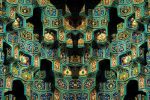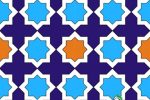cornice #7

cornice #7
The Islamic stage architecture is also the expression of arts such as painting, calligraphy, etc., which has followed its path of evolution in different periods, especially from the Ilkhanid era to the Safavid period. Open space in Islamic architecture always creates an environment with greatness and spiritual purity with the harmony and order of patterns, inscriptions and colors. When a person enters these places, he finds himself in the middle of a spiritual world that is reminiscent of the paradise mentioned in the Qur’an.
According to the inscriptions that have been obtained so far, inscription writing started with the Kufi script and this script was the only script used for writing inscriptions until about the fifth century of Hijri, and from this date onwards, other scripts are also used in a limited way. Until the 7th century, most of the inscriptions were written in the Kufic script, and from the 8th century onwards, the third script was used more often in writing inscriptions, although Kufic inscriptions are still common. Kufi line is widely used in the tiling of buildings, the building line, which is the same as angular kufi, is obtained by drawing square, rhombus, rectangle geometric shapes and parallel and intersecting lines.
The type of script at the beginning of the Safavid era was Kufi and Tholt script, which was used to write sacred texts, but the dominant script in the inscriptions of this era was the suspension script, the popular national script of the Safavid period, and in the Shah Abbas era, the Nastaliq script, which is a mixture of Nashq. And suspension is invented. Examples of these examples include Sheikh Lotfollah Mosque, Imam Mosque, Nimvard School in Isfahan, etc.
In the Safavid period, the themes of the inscriptions changed due to the change of religion to Shia, these inscriptions are either in the form of prayers or in the form of hadiths, and inscriptions that specify the date of construction, the name of the architect, etc. are still evident. The inscriptions of Islamic buildings are usually made of brick, tile, stone, plaster and wood. The text of the words of the inscription is usually the blessed names of God Almighty, verses and chapters of the Quran, the blessed names of the Prophet (PBUH) and imams, prayers, supplications, religious slogans, the name of the person who commissioned the work, the name of the ruler or sultan of the time, the name of the creator of the work, the name of the scribe and It includes calligraphers, the history of the creation of the work, Persian and Arabic poems, the sayings of elders and sages, the orders of kings and covenants, and advice.








